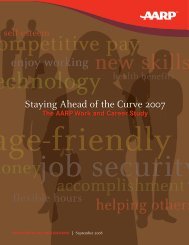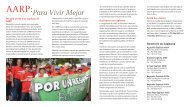The New Aging Enterprise - aarp
The New Aging Enterprise - aarp
The New Aging Enterprise - aarp
Create successful ePaper yourself
Turn your PDF publications into a flip-book with our unique Google optimized e-Paper software.
RetirementJobs, and Curves) or by nonprofit initiatives (Eden Alternative and Experience Corps)<br />
is not the question. <strong>The</strong> question rather relates to the role of individual agency or self-initiated<br />
action in contrast to some hegemonic structure (bureaucracy or market) that would otherwise<br />
inhibit freedom and self-fulfillment. When elder participants in these <strong>New</strong> <strong>Aging</strong> <strong>Enterprise</strong><br />
programs “vote with their feet,” we cannot simply dismiss their responses as “false<br />
consciousness.” On the contrary, their participation itself has helped to foster and sustain the<br />
new life-world manifest in their activities themselves.<br />
Business ventures described as part of the <strong>New</strong> <strong>Aging</strong> <strong>Enterprise</strong> range from a web-based<br />
portal (RetirementJobs) to the franchise model (Curves) to a privately held corporate model<br />
(Erickson). A more thorough analysis of the character of these ventures would suggest many<br />
ways in which they meet the profile established by Jim Collins in Good to Great. <strong>New</strong> <strong>Aging</strong><br />
<strong>Enterprise</strong>s also match many of the criteria for “natural capitalism” 113 enunciated by Paul<br />
Hawken in his visionary writings on this subject. For nonprofits, as for business ventures, the<br />
key question is sustainability: can the nonprofit enterprise move beyond dependence on<br />
foundation grants or the enthusiasm of a founder to develop a dependable income stream that<br />
will enable it to endure over time? An important factor here is whether the nonprofit enterprise<br />
develops its fee-based revenue stream and operates in a “business-like” fashion while still<br />
remaining faithful to its nonprofit mission. By these standards, Elderhostel, successful after<br />
more than 30 years, clearly meets the test.<br />
<strong>The</strong> <strong>New</strong> <strong>Aging</strong> <strong>Enterprise</strong> describes a path toward innovation and enhanced freedom<br />
that invites us to question old paradigms, for example, government versus the marketplace. In a<br />
similar vein, Gilleard and Higgs conclude their book, <strong>The</strong> Cultures of Ageing, 114 with these<br />
words: “…the aim of an increasingly commodified economy is to a maximize people’s ability to<br />
spend at each and every point in their life course.” This formulation of course leaves some<br />
questions unanswered. For example, what about persistent poverty in later life? <strong>The</strong>ir own<br />
solution to inequities in old age is for people earlier in the life course to have better jobs and<br />
therefore better retirement income later on. As a result, people would spend more in later life,<br />
now incorporated into that flux of expanding capitalism foreseen by Marx in his evocative<br />
phrase, “all that (is?) solid melts into air.” Gilleard and Higgs insist that they are trying merely<br />
to document this ever-advancing differentiation into commodified “cultures in ageing.”<br />
But is advancing commodification the only foreseeable scenario for an aging society?<br />
<strong>The</strong> message from the <strong>New</strong> <strong>Aging</strong> <strong>Enterprise</strong>s is quite different. <strong>New</strong> <strong>Aging</strong> <strong>Enterprise</strong>s do not<br />
constitute endless “commodification,” which Habermas has termed “colonization of the lifeworld.”<br />
True, Elderhostel is a merchandiser of educational travel but it is hardly well described<br />
as a bundle of commodities, unless one wishes to claim that anything mediated by a market has<br />
ipso facto become a commodity. <strong>The</strong> same holds true for other businesses like Curves or<br />
RetirementJobs. Organizations such as Universities of the Third Age or Experience Corps<br />
cannot remotely be described as “commodified” in their relationship to older people. <strong>New</strong><br />
<strong>Aging</strong> <strong>Enterprise</strong>s indeed embody the “Third-Ageism” and “project of the self” which Gilleard<br />
and Higgs find attractive as part of the “cultural turn” celebrated in their book. But the cultural<br />
turn, and the primacy of agency, should not be equated with the marketplace, still less with<br />
commodification.<br />
38










